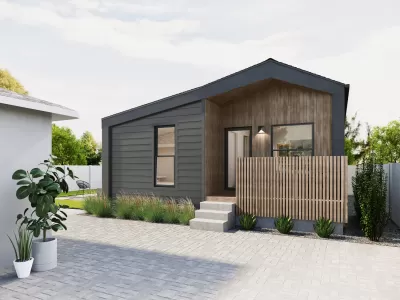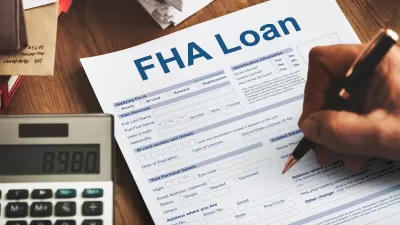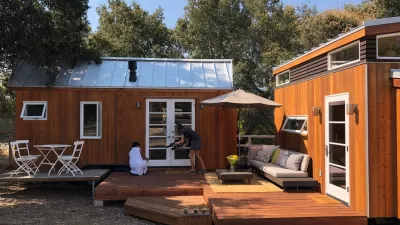How can we get more accessory dwelling units built, keep them affordable, and make them a force for increasing racial equity?

Accessory dwelling units, or ADUs, have become one piece of an answer to building a housing system that has enough housing, at the right cost, for everyone. Because they tend to be smaller, ADUs are theoretically more affordable. These smaller units can be added to current single-family homes—in backyards, basements, or over garages—and they don’t add to sprawl. They bring rental options to places that lack them, and can give homeowners a little additional cash flow.
But as Shelterforce explored last year in the Under the Lens series ADUs Explained, it’s not quite as simple to implement as it sounds.
Shelterforce’s Miriam Axel-Lute recently moderated a conversation about accessory dwelling units during Next City’s Solutions of the Year convening.
Miriam Axel-Lute: There are three separate questions when it comes to ADUs, affordability, and equity. First, how to get them built in any quantity. But then there are two other intertwining questions that are of central importance. One, how to make building an ADU feasible for and accessible to the lower-income homeowners who could use the cash flow the most and to the homeowners of color who’ve been excluded from building the kind of equity in their homes that would make financing an ADU easier, and also how to create ADU units that are themselves accessible and affordable to the lower-income renters. Our speakers today are working on these questions, but especially those last two, coming at it from different angles in different parts of the country.
I’m going to start off our discussion by turning things over to Nikki Beasley and Domanic Green, who work with the Keys to Equity program in California.
Nikki Beasley: We have been on the mark of creating innovation, as it relates to figuring this thing out, and it’s good to know we are not alone. We sit in the city of Richmond, California, supporting Alameda, Contra Costa, and Solano counties.
The Keys to Equity program is specific to the city of Oakland homeowners, with a guided principle of helping the Black homeowner. It is not an exclusive program, but some of the data shows that the Black homeowner definitely deserves the opportunity to have some focus. Since 2011, rent in the city has increased over 72 percent. Eighty percent of Oakland’s lowest-income households are cost burdened as relates to the amount of their income going to their rental housing, and as many Bay Area cities have acknowledged, there’s been an exodus of the African American community in the city of Oakland, and in the Bay Area. Oakland at one time had the highest concentration of Blacks, but it is now transitioned.
Because of that, we wanted to think through our approach. This whole program was started early 2020. The city of Oakland reached out to the Chan Zuckerberg [Initiative] and said, “Hey, we have an idea. What if we try to bring accessory dwelling units to the homeowners with the explicit purpose of focus on the Black homeowner?”
Through that process an RFP was created. Richmond Neighborhood Housing Services, along with other community partners, came up with an idea. It was selected, and then in 2021, we worked on the execution, and this program officially launched in October 2021. And the strategic approach is continuing to work with public private partnerships because it is very clear that there are many moving parts to the work. So it’s imperative that we have ...
Please see the source article to continue reading.
FULL STORY: Taking the ADU Model to the Next Level, a Shelterforce and Next City Webinar

Study: Maui’s Plan to Convert Vacation Rentals to Long-Term Housing Could Cause Nearly $1 Billion Economic Loss
The plan would reduce visitor accommodation by 25,% resulting in 1,900 jobs lost.

North Texas Transit Leaders Tout Benefits of TOD for Growing Region
At a summit focused on transit-oriented development, policymakers discussed how North Texas’ expanded light rail system can serve as a tool for economic growth.

Why Should We Subsidize Public Transportation?
Many public transit agencies face financial stress due to rising costs, declining fare revenue, and declining subsidies. Transit advocates must provide a strong business case for increasing public transit funding.

How to Make US Trains Faster
Changes to boarding platforms and a switch to electric trains could improve U.S. passenger rail service without the added cost of high-speed rail.

Columbia’s Revitalized ‘Loop’ Is a Hub for Local Entrepreneurs
A focus on small businesses is helping a commercial corridor in Columbia, Missouri thrive.

Invasive Insect Threatens Minnesota’s Ash Forests
The Emerald Ash Borer is a rapidly spreading invasive pest threatening Minnesota’s ash trees, and homeowners are encouraged to plant diverse replacement species, avoid moving ash firewood, and monitor for signs of infestation.
Urban Design for Planners 1: Software Tools
This six-course series explores essential urban design concepts using open source software and equips planners with the tools they need to participate fully in the urban design process.
Planning for Universal Design
Learn the tools for implementing Universal Design in planning regulations.
City of Santa Clarita
Ascent Environmental
Institute for Housing and Urban Development Studies (IHS)
City of Grandview
Harvard GSD Executive Education
Toledo-Lucas County Plan Commissions
Salt Lake City
NYU Wagner Graduate School of Public Service





























